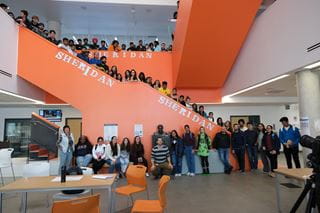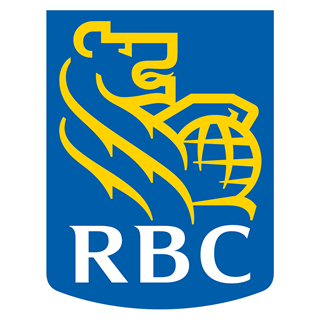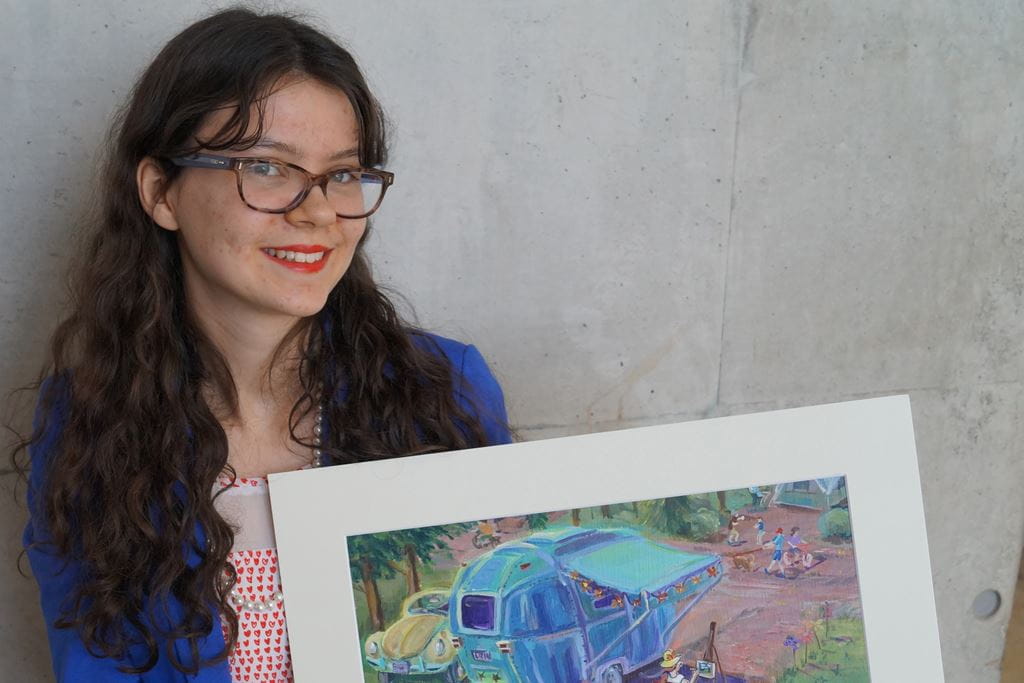
Small business, big start
 by Keiko Kataoka – Feb 19, 2016
by Keiko Kataoka – Feb 19, 2016 At Sheridan, where creativity is purposefully infused in programs across its six Faculties, it’s no surprise that students are inspired to innovate on their creative ideas, and in some cases, mold a space of their own to share the result. Three enterprising students at Sheridan, who have decided to start their own small businesses while completing their studies, are examples of this concept in action.
While their goods and services differ – acrylic portraits, custom bowties, and hand-painted ceramics – the motivation behind their enterprises is similar. These students were looking to hone their creative energies, set up a source of income, practice what it takes to run a business in a relatively low-risk environment, and in turn, establish a foundation from which they draw experience and launch into the workforce upon graduating.
Meet three of Sheridan’s student entrepreneurs: Samantha Luck, Dan Amponsah (aka Kobi), and Kirsti Smith.
Samantha Luck, Owner of Sam Luck Home and Cottage Portraits
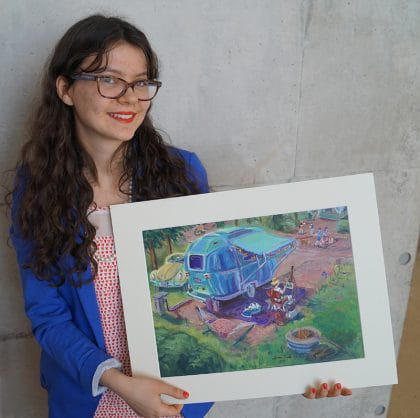
After her first year in Sheridan’s Bachelor of Illustration program, Samantha Luck returned home to Sault Ste. Marie, eager to continue working on her art at the same pace as she had been all year. After completing a few paintings of local sites and scenery, her mother suggested that there may be a market for home portraits. Running with this idea Luck selected a few homes, painted each one in acrylic on canvas and left the finished product in an envelope on their doorsteps. She included her business card and a note with each package reading: ‘This is a gift to you but if you like it and would like to donate money, please let me know.’ This unconventional marketing approach proved to be effective.
Her first business lesson in branding came about quickly; she originally named her business Sam Luck House Paintings, which yielded inquiries about the cost of painting home interiors, so she switched to something more descriptive: Sam Luck Home and Cottage Portraits. In the summer of 2015 she applied for a business grant through Ontario government’s Summer Company program and used the $1500 start-up fund to promote her small business by starting a website, printing flyers and taking out an ad in Our Homes Magazine.
“The Summer Company organizers were skeptical as to whether I’d remain busy all summer,” says Luck. A few weeks in, she was painting almost every day. She attributes the appeal of her business with the connection many people have to their homes and pride of ownership. The niche that Luck has tapped into suits her self-described whimsical painting style well. “Houses have so much character that can come across in the painting,” she says. “It’s fun to give life to an inanimate object.”
“Houses have so much character that can come across in the painting. It’s fun to give life to an inanimate object”
– Samantha Luck
Luck’s business model is straightforward: customers contact her by phone or email for a portrait and depending on the proximity of the property to her home, she drives to take photos to use for the painting or they are provided by customers, which she then uses to complete the portrait. Each one can take two to four hours, depending on the size of the canvas the customer selects, and the finished product is delivered by mail. She keeps her website and Facebook page updated with all of the paintings she has completed. To date, Luck has sold more than 200 portraits.
On one memorable occasion, she was commissioned to complete three different paintings of a backyard garden. She spent a picturesque day in a beautiful backyard working on her craft. “I got to chat with the homeowners as I painted and hear the history and stories about the home,” she says. “I’ve met a lot of interesting people in this line of work.” For another job she was hired by a real estate agent to paint portraits of 19 different homes to be used as housewarming gifts for clients.
While her ultimate career dream is to work as a visual development artist designing assets and backgrounds for Pixar films, her home-painting business will remain her means of income while in school and has the potential to translate as freelance work in whichever city she ends up living. Perhaps one of the biggest gains for Luck in business ownership is how it has greatly improved her communication skills. “I almost missed out on an opportunity in high school to study abroad in Japan because I was so nervous in the interview,” she explains. “I now rely heavily on my communication skills to effectively market my business.”
Luck has inspired some of her peers in the illustration program to consider their own ventures. “If you have a strong business plan and know there’s a market for it, then go for it,” she advises. “It’s all about enthusiasm and passion – customers will see that, enjoy it, and want to buy from you.”

Dan Amponsah (aka Kobi), Owner and Founder of Neck Couture

Fourth-year Bachelor of Health Sciences – Kinesiology and Health Promotion student Dan Amponsah (aka Kobi) gives new meaning to the term startup. Always fashion-conscious, he decided that it would be more economical to make the bowties that he so often wears rather than purchase them from the store. He reached out to a non-profit art organization in Brampton, signed up for sewing classes, learned how to create bowties from scratch, and in 2014, started selling them through his business Neck Couture by Kobi.
Kobi’s business stands out from other accessory lines as he sources unique Kente fabric, representative of his Ghanaian roots, and provides a style-consultation to his customers before he starts his custom creations. “Customers are willing to spend the $50 to $70 on a bowtie that speaks to their style,” he explains. “These aren’t mass-produced; I source the fabrics and make sure that it’s a piece that the customer will have in their wardrobe forever.” Some of his bestsellers include a Kente-black leather combination bowtie and a wooden bowtie made of hand-carved vaneer.
Neck Couture got a financial boost from Summer Company, a program which also helped him connect with other small business owners whom he hired for web design and photography. Today, he works solo on his business, responding to customer inquiries, maintaining his website, sourcing fabrics, making bowties, and keeping his Instagram page fresh with content to attract customers, something Kobi says could be a full-time job on its own.
“When I started my business, that’s when my grades went up. I stopped wasting time. I didn’t have time to waste and became very efficient”
– Dan (Kobi) Amponsah
Although studying in the field of kinesiology, Kobi couldn’t ignore his entrepreneurial spirit, which he credits his mother with instilling in him at a young age. While his parents are supportive of Neck Couture, they also expect him to finish his degree on schedule. Fortunately, his business experiences complement his studies. “When I started my business, that’s when my grades went up,” he explains. “I stopped wasting time. I didn’t have time to waste and became very efficient.”
In addition, Kobi’s experience customizing bowties for buyers has improved how he interacts with athletes and clients. And he has had a lot of experience from which to draw, having sold more than 300 bowties to date. “No matter who I’m training – athletes, general clients, the young and elderly – I need to customize a plan for each person with confidence. This is the same in my business,” he explains. “I am catering to the needs of a wide demographic with specific styles and need to do it in a professional manner.”
Part of Kobi’s marketing efforts include getting his product into the right hands and he’s already given bowties to film director and producer Spike Lee, and rapper and record executive Kardinal Offishall. While the celebrity nod is a big deal for a small business, he is most humbled when working with customers who are looking for groomsmen accessories on their wedding days. “That may be the most gratifying part of the business – being asked to be part of one of the most special day in someone’s life,” says Kobi.
The future of Neck Couture may include offering other accessories and custom suits. In the meantime, Kobi is focused on continuing with his bowtie production and graduating in the spring of 2016.

Kirsti Smith, Owner of Kirsti Smith Ceramics
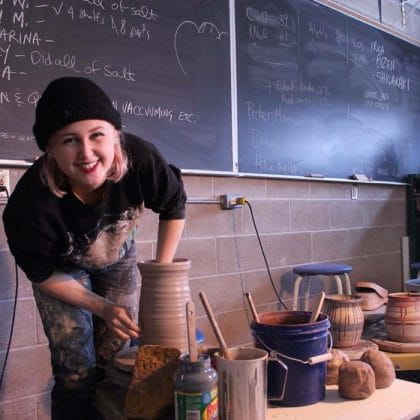
Ceramic artist and second-year Bachelor of Craft and Design student Kirsti Smith started her small business, Kirsti Smith Ceramics, out of necessity. In the summer of 2015 while working as a technician in Kingston for the Women’s Art Festival, she stepped in to fill an empty table at the show and needed a business name under which to sell her pieces. It was her first experience selling her ceramics and her mother advised her to manage her expectations. “She told me not to be upset if I didn’t sell anything and that it would be a good experience regardless of the outcome,” she explains smiling. “I ended up being featured in the Peterborough Examiner newspaper and selling nine pieces. I was thrilled.”
Smith describes her ceramics as functional ware with a feminine flare including bowls, vases and mugs. Her work often incorporates hand-painted floral surface decoration and sgraffito (a decorating pottery technique produced by applying layers of colour or colours and scratching off part of the layer). She draws inspiration from other ceramic artists who use similar firing and decorating techniques.
The focus for Smith at this stage of her business is networking. “My day is consumed with all things relating to ceramics so I want to start building strong contacts with my peers, professors and other artists now so that I don’t lose touch with them down the road,” she says. She establishes relationships with contacts by staying active on social media channels like Instagram, Twitter, and Facebook and through blogging. Luckily for Smith, she is rarely at a loss for content; she keeps her channels fresh by posting progress of her class projects, which later serve as pieces she can sell.
One social media ‘win’ for Smith happened over the winter break. She received one of Kristen Kieffer’s ceramic mugs as a Christmas gift and posted a photo of herself with it on Instagram, tagging the artist whom she greatly admires. Kieffer re-posted it on her own account with the caption: “The next generation of ceramic artists.” This resulted in more followers and likes on Smith’s account and an inquiry from a woman in New York City who is interested in purchasing one of her pieces.
Although two years away, Smith is already thinking about her future in ceramics after graduation. She hopes to find an artist residency for a couple of years and then pursue her business full-time. Until that time arrives, she is eager to find a mentor that will help her grow as a ceramic artist and entrepreneur, and looks forward to a business course offered to third-year Sheridan Craft and Design students. “I don’t want to be a deer in the headlights when I graduate and start from scratch,” she explains. “The path I’m taking now helps me learn one step at a time and I have a place to jump off from.”
“I don’t want to be a deer in the headlights when I graduate and start from scratch. The path I’m taking now helps me learn one step at a time and I have a place to jump off from”
– Kirsti Smith
Measuring growth and success with a dollar amount isn’t Smith’s focus. She is more concerned with developing her craft, building her body of work, and learning how to engage with other artists and potential customers on digital channels. “I think if I ever experience someone being as moved by my work as I am by the work of my favourite ceramic artists like Kieffer, I would be happy,” she says. “That would be my measure of success.”

Pictured at top of page: Sam Luck, Sheridan Illustration Student and Small-Business Owner
Written by: Keiko Kataoka, Manager, Communications and Public Relations at Sheridan.
Media Contact
For media inquiries, contact Sheridan’s Communications and Public Relations team.


